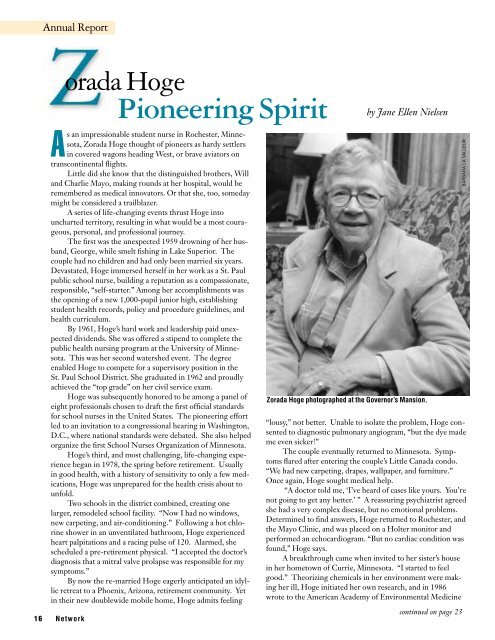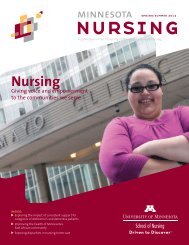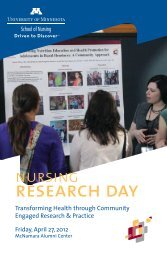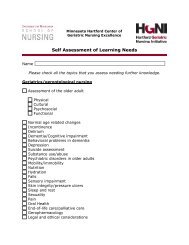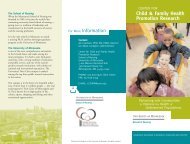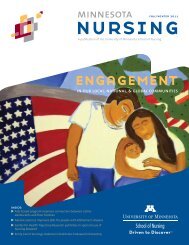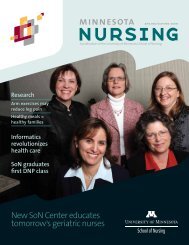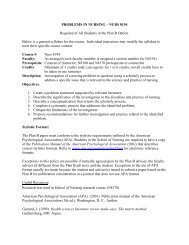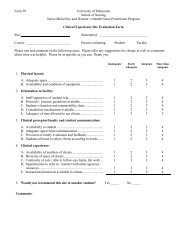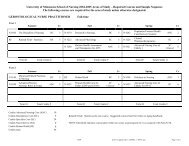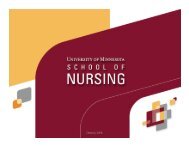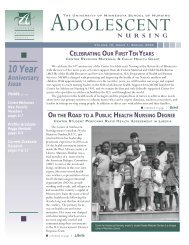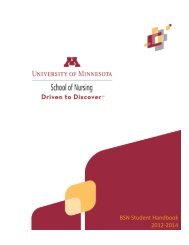Fall/Winter 2002 - School of Nursing - University of Minnesota
Fall/Winter 2002 - School of Nursing - University of Minnesota
Fall/Winter 2002 - School of Nursing - University of Minnesota
You also want an ePaper? Increase the reach of your titles
YUMPU automatically turns print PDFs into web optimized ePapers that Google loves.
Annual Report><br />
As an impressionable student nurse in Rochester, <strong>Minnesota</strong>,<br />
Zorada Hoge thought <strong>of</strong> pioneers as hardy settlers<br />
in covered wagons heading West, or brave aviators on<br />
transcontinental flights.<br />
Little did she know that the distinguished brothers, Will<br />
and Charlie Mayo, making rounds at her hospital, would be<br />
remembered as medical innovators. Or that she, too, someday<br />
might be considered a trailblazer.<br />
A series <strong>of</strong> life-changing events thrust Hoge into<br />
uncharted territory, resulting in what would be a most courageous,<br />
personal, and pr<strong>of</strong>essional journey.<br />
The first was the unexpected 1959 drowning <strong>of</strong> her husband,<br />
George, while smelt fishing in Lake Superior. The<br />
couple had no children and had only been married six years.<br />
Devastated, Hoge immersed herself in her work as a St. Paul<br />
public school nurse, building a reputation as a compassionate,<br />
responsible, “self-starter.” Among her accomplishments was<br />
the opening <strong>of</strong> a new 1,000-pupil junior high, establishing<br />
student health records, policy and procedure guidelines, and<br />
health curriculum.<br />
By 1961, Hoge’s hard work and leadership paid unexpected<br />
dividends. She was <strong>of</strong>fered a stipend to complete the<br />
public health nursing program at the <strong>University</strong> <strong>of</strong> <strong>Minnesota</strong>.<br />
This was her second watershed event. The degree<br />
enabled Hoge to compete for a supervisory position in the<br />
St. Paul <strong>School</strong> District. She graduated in 1962 and proudly<br />
achieved the “top grade” on her civil service exam.<br />
Hoge was subsequently honored to be among a panel <strong>of</strong><br />
eight pr<strong>of</strong>essionals chosen to draft the first <strong>of</strong>ficial standards<br />
for school nurses in the United States. The pioneering effort<br />
led to an invitation to a congressional hearing in Washington,<br />
D.C., where national standards were debated. She also helped<br />
organize the first <strong>School</strong> Nurses Organization <strong>of</strong> <strong>Minnesota</strong>.<br />
Hoge’s third, and most challenging, life-changing experience<br />
began in 1978, the spring before retirement. Usually<br />
in good health, with a history <strong>of</strong> sensitivity to only a few medications,<br />
Hoge was unprepared for the health crisis about to<br />
unfold.<br />
Two schools in the district combined, creating one<br />
larger, remodeled school facility. “Now I had no windows,<br />
new carpeting, and air-conditioning.” Following a hot chlorine<br />
shower in an unventilated bathroom, Hoge experienced<br />
heart palpitations and a racing pulse <strong>of</strong> 120. Alarmed, she<br />
scheduled a pre-retirement physical. “I accepted the doctor’s<br />
diagnosis that a mitral valve prolapse was responsible for my<br />
symptoms.”<br />
By now the re-married Hoge eagerly anticipated an idyllic<br />
retreat to a Phoenix, Arizona, retirement community. Yet<br />
in their new doublewide mobile home, Hoge admits feeling<br />
16 Network<br />
orada Hoge<br />
Pioneering Spirit<br />
by Jane Ellen Nielsen<br />
Zorada Hoge photographed at the Governor’s Mansion.<br />
“lousy,” not better. Unable to isolate the problem, Hoge consented<br />
to diagnostic pulmonary angiogram, “but the dye made<br />
me even sicker!”<br />
The couple eventually returned to <strong>Minnesota</strong>. Symptoms<br />
flared after entering the couple’s Little Canada condo.<br />
“We had new carpeting, drapes, wallpaper, and furniture.”<br />
Once again, Hoge sought medical help.<br />
“A doctor told me, ‘I’ve heard <strong>of</strong> cases like yours. You’re<br />
not going to get any better.’ ” A reassuring psychiatrist agreed<br />
she had a very complex disease, but no emotional problems.<br />
Determined to find answers, Hoge returned to Rochester, and<br />
the Mayo Clinic, and was placed on a Holter monitor and<br />
performed an echocardiogram. “But no cardiac condition was<br />
found,” Hoge says.<br />
A breakthrough came when invited to her sister’s house<br />
in her hometown <strong>of</strong> Currie, <strong>Minnesota</strong>. “I started to feel<br />
good.” Theorizing chemicals in her environment were making<br />
her ill, Hoge initiated her own research, and in 1986<br />
wrote to the American Academy <strong>of</strong> Environmental Medicine<br />
continued on page 23<br />
BARBARA LA VALLEUR


